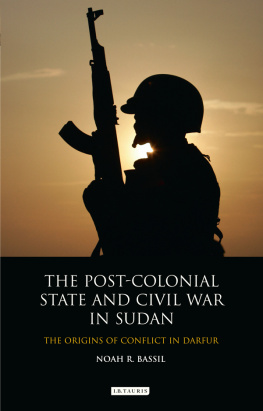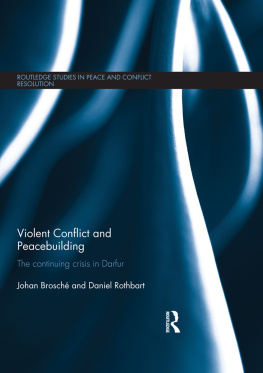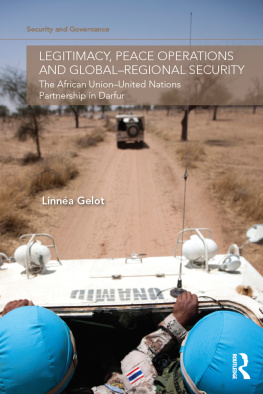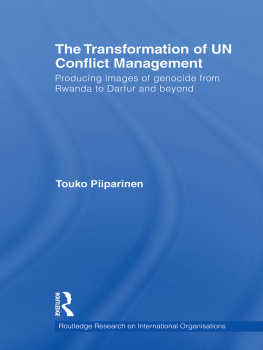The University of Chicago Press, Chicago 60637
The University of Chicago Press, Ltd., London
2021 by The University of Chicago
All rights reserved. No part of this book may be used or reproduced in any manner whatsoever without written permission, except in the case of brief quotations in critical articles and reviews. For more information, contact the University of Chicago Press, 1427 E. 60th St., Chicago, IL 60637.
Published 2021
Printed in the United States of America
30 29 28 27 26 25 24 23 22 21 1 2 3 4 5
ISBN -13: 978-0-226-76169-5 (cloth)
ISBN -13: 978-0-226-76172-5 (paper)
ISBN -13: 978-0-226-76186-2 (e-book)
DOI : https://doi.org/10.7208/chicago/9780226761862.001.0001
Library of Congress Cataloging-in-Publication Data
Names: Abusharaf, Rogaia Mustafa, author.
Title: Darfur Allegory / Rogaia Mustafa Abusharaf.
Description: Chicago : The University of Chicago Press, 2021. | Includes bibliographical references and index.
Identifiers: LCCN 2020027869 | ISBN 9780226761695 (cloth) | ISBN 9780226761725 (paperback) | ISBN 9780226761862 (ebook)
Subjects: LCSH: GenocideSudanDarfur. | Ethnic conflictSudanDarfur. | SudaneseSudanDarfurSocial conditions. | SudaneseSudanDarfurEthnic identity. | SudaneseForeign countries. | PostcolonialismSudan. | SudanHistoryDarfur Conflict, 2003 | SudanHistoryDarfur Conflict, 2003Refugees.
Classification: LCC DT 159.6. D 27 A 32 2021 | DDC 962.404/3dc23
LC record available at https://lccn.loc.gov/2020027869
This paper meets the requirements of ANSI/NISO Z 39.48-1992 (Permanence of Paper).
Unmuting Darfuri Voices
... a death space in the land of the living where tortures certain uncertainty fed the great arbitrariness of power, power on the rampagethat great steaming morass of chaos that lies on the underside of order and without which order could not exist.
MICHAEL TAUSSIG , Shamanism, Colonialism, and the Wild Man
Umm Kwakiyya: Why Darfur Allegory?
Darfur, the Sudans westernmost region, is a frontier of violence, a space of death in the words of anthropologist Michael Taussig, or, as its inhabitants had appositely termed the violence they endured more than a century ago, an Umm Kwakiyya, a state of damnation. I understood the new iteration of violence that erupted in 2003 as Umm Kwakiyya, a space of death, for the terms can easily be used interchangeably. This is the allegory that compelled me to undertake this difficult ethnography. In what sense is Darfur a space of death, its state of affairs that of Umm Kwakiyya?
The word for allegory in Arabic is ibra, which literally means the lesson learned. The ibra of Darfur lies in its lessons about the impact of multiple and intersecting levels of violence stemming from colonial rule, environmental degradation, and crimes against humanity. This ibra in essence is not very different from the definition of allegory in ethnographic, aesthetic, and cultural studies: Allegory, writes Andrew Edgar in Key Concepts in Cultural Theory, is a drama, poem, picture or other work of art in which characters and events are used to represent or personify a deeper veiled meaning. Clifford goes on to point out the allegory of the ethnographer:
A recognition of allegory complicates the writing and reading of ethnographies in potentially fruitful ways. A tendency emerges to specify and separate different allegorical registers within the text. The marking off of extended indigenous discourses shows the ethnography to be a hierarchical structure of powerful stories that translate, encounter, and recontextualize other powerful stories.
What do these definitions imply for titling this ethnography Darfur Allegory? As we shall see in the chapters that follow, Darfurs deeper meaningsits ibralead us to an understanding of the encoding, reproduction, and exposure of political power. From this it follows that the categories typically deployed for understanding the root cause of the Darfur tragedy have failed to engage the tactics of political power.
In his formidable account of the Sultanate of Darfur over the centuries, historian Rex Sen OFahey exposed us to what Darfuris called Umm Kwakiyya, referring, he said, to the damnation of Darfur. He writes, Umm Kwakiyya was the Arabic term used by my informants in the 1970s to describe the period 187498, when, following the destruction of the first Sultanate, Darfur experienced all the miseries that it is presently enduring. The stories of Darfur that many of the interlocutors in this ethnography tried to tell, whether in depth or with economy, represent a kind of a neoUmm Kwakiyya, an utter devastation that has continued to pound Darfur with astonishing force. In pondering the enormous pain of Darfuri people across time and location, I thought often that Umm Kwakiyya is a proper allegory of their experiences, at once evocative of OFaheys work and reflective of the underlying situations that I sought to register here. For underneath the painful experiences I have recorded are crosscutting storiesabout colonialism, local knowledge, the environment, gender, and especially about the misuse of racial and ethnic categories.
Darfur Allegory is also about a plurality of competing narratives. As a Sudanese writing about Darfur, I see my role as mediating and prismatic, yet also adequate to confer some insights through my encounters with Darfur at home and abroad. I intentionally have chosen to present detailed accounts participants shared with me during the course of my ethnographic research. Darfur Allegory then is also about unmuting Darfuri voices. We need to be wary of the dangers of a single story, as Nigerian novelist Chimamanda Ngozi Adichie cautions us. The notion of allegory then helps scaffold the stories Darfuri people in and outside of the Sudan have told me in this ethnography.
In all their competing plurality, the stories in this ethnography pull back the curtain on a region in ruin. Darfur seems to have perpetually lived on a knifes edge, in a space of death that has become a classic laboratory not only for understanding key questions about Afro-Arab politics and society but also for exposing the tenuous human relations in a postcolonial state that sleepwalked itself into disaster. It is the realm of human relationships produced by the kaleidoscopic power of the state that dominates this ethnography. Although it is important to note that Darfuri people have interacted with the state in highly differentiated ways, with some joining then-president Omar Al-Bashir in an alliance predicated on economic interest and political opportunism, the majority has withstood systematic brutalization. For this reason, explanations of Darfurs mayhem do not lend themselves to a Manichean mode of reasoning based on predetermined taxonomies and prior texts. Within the voluminous literature on the conflict in Darfur that has appeared since 2003, the debate about the root cause of the conflict has turned primarily on race. Put simply, Arabism and Africanism have been thought to be on a collision course in the Sudan. Such a Manichean treatment of Darfurs troubles strips it of productive engagements with the colonial role in inventing those Arab and African identities. Also conspicuously absent are references to Britains brutal Darfur Campaign, which resulted in the annexation of the region to the Sudan, including the massacre of its last sultan, Ali Dinar. Although the politicization of ethnic identity and its ugly consequences are incontestable, I argue that we need to ask more questions about why this is the case.







